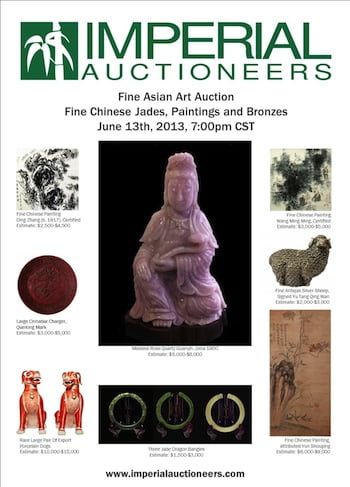As London prepares for a week of Asian art auctions in May, Dreweatts & Bloomsbury Auctions are delighted to present an extremely rare 17th century transitional hanging from the Ming/Qing dynasty, which will headline their spectacular sale of Chinese Ceramics and Asian Works of Art, including an extensive selection of Tibetan art, and Asian textiles. The sale will be held in their London saleroom in the heart of Mayfair on Saturday 17th May.

Aristocrats at the time would donate textiles to Tibetan monasteries as acts of devotion, and it was the Buddhist monks that would have created the patchwork hanging which includes rare examples of bed hangings and bed covers produced in the 17th century for a Western market fuelled by the expansion of European trade with China. The assemblage of the hangings was done with a ritual solemnity, signifying the monks’ vow of poverty and acceptance of an ascetic life modelled after the Buddha.
Framed with a fine brocade, the outer borders are made from further dragon panels woven using the Kesi (cut silk) technique, and parts of a late Ming period costume (Chaofu) in the Imperial colour of incense, (jin huang). This unique and exceptionally rare piece of Chinese-Tibetan history is estimated to sell for £12,000 – 18,000. [Lot 100]
A 14-15th century gilt bronze figure of the Shakyamuni Buddha in the bhumisparsamudra, or ‘enlightenment’, pose is the first of two extremely rare Tibetan figures sure to attract a great deal of interest. The Shakyamuni Buddha is the Buddha on whose teachings the Buddhist religion is founded and the bhumisparsamudra is said to be his hand gesture when he reached enlightenment. The figure is estimated at £4,000 – 6,000. [Lot 117]
The second (pictured right) is a very unusual Sino-Tibetan 18th century cast silver and repousse’ metalwork figure of Jambhala the Tibetan wealth deity, and an emanation of Avalokitesvara, the Bodhisattva (enlightened being) of Compassion. There are five Jambhala manifestations, each with their own way of helping to relieve poverty and promote financial stability. Crafted here in his white manifestation, he is removing the suffering of poverty and sicknesses through compassion. Originally sitting atop a lion, and holding the Wealth banner in his right arm the statue is estimated to sell for £4,000 – 6,000. [Lot 118]
A series of scroll paintings on cotton or silk, known as Thangkas, are highlighted by an extremely rare Sino-Tibetan example from the 19th century, which includes the distinguished hand impressions and seal of the Lama on the reverse. The scene depicts the multi-armed and eleven headed Avalokite?vara flanked by Manjusri, the bodhisattva associated with transcendent wisdom, and Vajrapani, one of the first bodhisattvas of Mahayana Buddhism, and protector and guide of the Buddha. They are surrounded, on either side, by musicians and above are the chief of the Four Heavenly Kings, Vajshravana, and deities Mahakala and Yama, protective guardians of the dharma. They all set within the celestial realm of the Buddha.
Unusual in format, the thangka is a brilliant adaptation of Indian, Chinese and Tibetan elements, and provides a powerful visualisation of the blissful state of enlightenment achieved through the cult of the Bodhisattva Avalokitesvara. It is estimated at £8,000 – 12,000. [Lot 133]
An extensive selection of Asian textiles, from official garments to a rare collection of children’s shoes and hats, are an unusual addition to the sale. Clothing children in auspicious garments has historically been part of Chinese traditional costumes, with children wearing several different styles of shoes and hats from infancy through adolescence that mimicked the features of especially powerful animals. The purpose was to protect children against evil spirits, or bestow good wishes of success and moral teaching.
The charming specimens included in this section, are a wonderful visual representation of the basics of the
Chinese decorative system, which involves the use of auspicious images, intended to act and become alive for the benefit of the wearer. These colourful garments, therefore, are an important resource to record popular contemporary beliefs and preoccupations, which official historical records often failed to document.
Notable amongst the collection are a collection of four 19th century Chinese silk embroidered shoes, shaped as fish, dragons, cats and Buddhist dogs, [Lot 86] and a collection of five festive hats for children from the late 19th and early 20th century, shaped as dragons, symbolising potent and auspicious powers, and butterflies, symbolising beauty, elegance and long life. [Lot 91] Both lots are estimated at £200-300.
The sale is on view at Bloomsbury House, Maddox Street, London, in the week prior to the sale. The auction will take place in the same venue. Online bidding with no additional premium will be available via www.dreweatts.com


